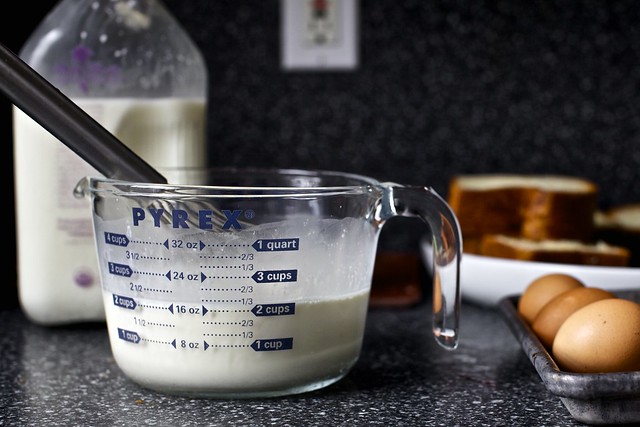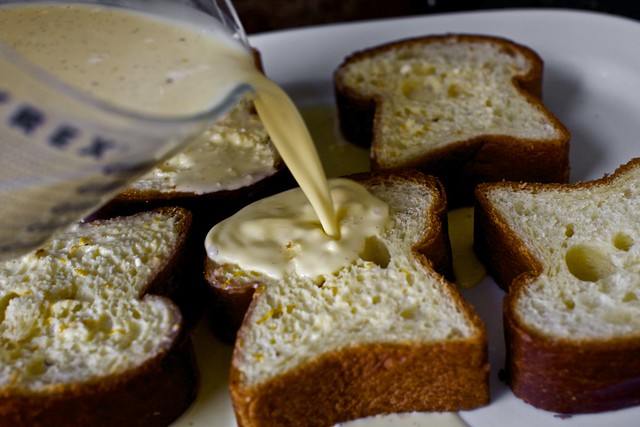crme brle french toasts
Filed under the very large category of Things Pretty Much Every New Yorker Already Knew About But Was News To Me (don’t bother trying to hail a cab after noon on a Friday, filthy stoops are irresistible for the chill-minded set, etc.), the City Bakery on 18th Street has some astoundingly good French toast on Sunday mornings. It’s also astoundingly expensive, as things will go at a bakery with sweets like you can’t find anywhere else and an iron grip on its original recipes. Their version is a ridiculously thick wedge of battered bread with a caramelized lid that requires no syrup or other accompaniment — well, except maybe some crispy salty strips of bacon — to make it sing.
Of course, I’m not trying to make their French toast, I would leave that to their expertise. I instead set out to make the French toast I began fantasizing about the second I had my first bite, a crème brûlée set within a thick slice of bread, one that would keep the burnt sugar lid but gild the caramel lilly even further and set it on a base that was more bread pudding-like than, well, honestly, imperfectly soaked/dry-centered French toast. (The sole City Bakery French toast flaw, in my opinion. Blasphemy, I know!) And I knew exactly how I’d do it. One thing I’ve learned when making French toast over the years is that as tempting as really, crazy thick French toast is, no matter how low you keep the pan temperature and how long you keep it on the stove, it’s very hard to cook it until it is set in the middle before burning the tops and bottoms. The solution is baking, which is brilliant in that the center is guaranteed to set and you’re guaranteed to enjoy cooking it more because it doesn’t require you to stand over a griddle dipping and flipping slice after slice for surely long than an entire tray of the same needs to bake. I could add “no butter” as a benefit but, come on, we’re making crème brûlée French toast here; this is no time to feign an interest in our arteries.
The snafu me and my poor little middle fingertip — leading to countless, “Look what I hurt today!” humor attempts with my husband later; yes, you’d be correct in guessing that I’m the only person around here who finds me funny — was in the burnt sugar lid. It being creme brûlée after all, I had wanted to torch it, but the uneveness of the top of the toast led the sugar to pool in the middle and the edges to, uh, erupt briefly into a match-sized flame and me to question whether my smoke detector even contained batteries. That plan swiftly scrapped, I decided to melt sugar the old-fashioned way, in a small pot on the stove. And look, I know caramel stresses people out and that’s why we start it with water and thermometers, but none of that is needed here. Add heat to sugar, give it time, and it will melt 100 percent of the time and by the time it is fully melted, it will be the color of honey. Once it is, act quickly but still not foolishly (i.e. getting your middle, or any finger in the 300 degree sugar’s path) pouring it over each slice and quickly use a butter knife or small offset spatula to spread it thinly over the tops. Too thick, you’ll have what my first go at this did — a hard candy lid, not that anyone complained between crunching smiles — but spread thin, you’ll have, hands down, the best French toast I have ever made. Now, do right by your mama and make this happen on Sunday.
One year ago: Leek Bread Pudding, Oatmeal Pancakes and Spring Asparagus Pancetta Hash
Two years ago: Cinnamon Raisin Bagels
Three years ago: Dulce de Leche Ice Cream
Four years ago: Corniest Corn Muffins and Pineapple Upside-Down Cake
Crème Brûlée French Toasts
Makes 6 servings
Toasts
1 loaf unsliced white bread, brioche or rich bread of your choice
1 1/3 cups whole milk
2/3 cup heavy cream
4 large eggs
1/3 cup granulated sugar
1/4 teaspoon fine sea salt or table salt
1 teaspoon Grand Marnier or another orange liqueur or 1/4 teaspoon orange zest
1 vanilla bean or 2 teaspoons vanilla extract
Topping
2/3 cup granulated sugar
Cut bread into 1 1/2-inch thick, generous slices; a 9-inch loaf should yield 6 slices. Whisk together milk, cream, eggs, sugar, salt, liqueur, and vanilla extract, if using. If using a vanilla bean, halve it lengthwise and scrape the pulp into a small dish. Whisk vanilla bean with one tablespoon of custard, then whisk in another and a third tablespoon, then pour the vanilla bean-custard mixture back into the main batter. This avoids having vanilla bean clumps that don’t disperse in your batter. Don’t you hate that?
Preheat oven to 325. Arrange bread slices on the smallest rimmed tray that will fit them in one layer (encourages maximum absorption) pour custard over slices. Allow them to absorb the custard for 30 minutes, turning the slices over at one point to ensure they’re soaking it up evenly. [Do ahead: You can also soak them overnight in the fridge. No need to flip them if so.]
Line a baking sheet with parchment paper. Transfer custard-soaked slices to prepared sheet, arranging them with a smidge of space between each to avoid making one French mega-toast. Flipping them halfway through if you wish, bake French toast slices for 30 to 35 minutes, until a slim knife inserted into the center of a slice and twisted ever-so-slightly does not release any wet custard. Keep warm until ready to serve.
To caramelize the tops: Either leave toasts on their baking sheet, or transfer to a serving platter. Have ready a small offset spatula and a potholder or trivet to rest your caramel pot on.
Melt remaining 2/3 cup sugar in a small, heavy, completely dry saucepan over moderate heat, stirring with a small spoon or fork until fully melted and the color of honey. Move it over to the potholder or trivet you’d set up and working quickly, spoon one generous tablespoon caramel over your first slice of toast, spread it thinly and evenly with your offset spatula and repeat with the remaining toasts. Because your caramel will continue to deepen slightly in color (veering towards almost-too-toasty) as you work, it’s best to work quickly but carefully. Let no fingers or forearms be harmed in the melted sugar’s path and should a single drop land on the counter or on your towel or on the rim of the plate, do not swipe it. Just leave it until it cools.
[Hot water will melt all hardened caramel and make your clean up job easy. Simply soak your pot/spoon/spatula and all will melt off.]
Serve with fresh berries and if you’re feeling extra fancy, loosely whipped cream. We don’t find that it needs any maple syrup.
Alternative top-caramelizing method: A really obvious question here would be “But would the broiler work?” The method would be to sprinkle each toast with 1 tablespoon of granulated sugar and let the broiler do the torching for you. However, my broiler doesn’t work. Never has, so I cannot test this. But, if it’s anything like my attempt (explained in the post) to use a blowtorch, I’m not feeling overly confident about it because the unevenness of the toasts leads to edges singeing before the sugar fully melts. But if you try this method, please report back in the comments as to how it went. I’m sure plenty of folks would prefer to avoid melting sugar.
Share this:
Related
ncG1vNJzZmirnZ7BtbHNpKCtm5iau2%2BvzqZma2hhZnxxgY6cqZ6llWKvs8HLnpxmnqKau6S0jK2mmqukqHw%3D






